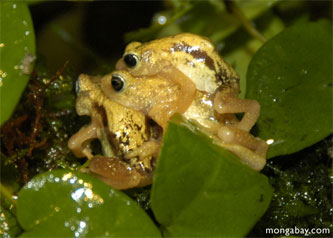Dire consequences if global warming exceeds 2 degrees says IUCN
IUCN release
November 29, 2005
Montreal, Canada—The parties to the United Nations Framework Convention on Climate Change must keep global warming below 2 degrees Celsius, says the World Conservation Union (IUCN).
The consensus of international conservation organizations is that if temperatures rise above 2 degrees Celsius from pre-industrial levels, massive species extinctions and dramatic changes in ecosystems will have severe consequences for human wellbeing.
“The Kyoto Protocol was an important milestone, but it is simply not enough. This conference must find new ways to achieve more serious emissions reductions after 2012 when the Kyoto Protocol expires,” says Achim Steiner, Director General of the World Conservation Union.
Recent studies have even predicted that up to one million species could go extinct due to climate change. Whatever scenario one may refer to, the number of reports of extinctions and changes in ecosystems are increasing already.
On November 28, 2005 parties to the UN Framework Convention on Climate Change and, for the first time, the parties to the Kyoto Protocol are meeting in Montreal, Canada over the next two weeks.
One Million Species Could Go Extinct Due To Climate Change
Canada’s boreal forests may be impacted by climate change more than many other regions. Boreal forests could decline in response to climate change, through factors such as increased incidences of diseases, pest infestations, fires, invasive species, severe weather events, or reduced rainfall.
 The Kihansi Spray Toad is one of the world’s most endangered species of amphibians. It may now be extinct in the wild. |
While for some ecosystems there are only warnings for the future, in others the impacts of climate change are already visible.
“We now receive more and more evidence that corals in the Caribbean are dying at an unprecedented speed and scale. While coral bleaching cannot be attributed to climate change alone, nature is giving us plenty of warning signs to reduce our emissions and adapt our resource management strategies,” says Carl-Gustaf Lundin, Head of IUCN’s Global Marine Programme.
One-third of all amphibians and reptiles are threatened with extinction, with climate change being one of the causes, as shown by the Global Amphibian Assessment released earlier this year.
Climate Change Puts Human Well-being At Risk
Extinction of species and changes in habitats put human well-being at risk. Human livelihoods are affected if plant or animal species go extinct, since many communities use them as sources of food, fuel and income. Furthermore, changes in rainfall and temperatures will impact agriculture—the crops that are produced and the contribution that biodiversity makes to these production systems, for instance through pollination, water provision, or pest control.
Related articles Carbon in Canada’s boreal forest worth $3.7 trillion, Ecosystem services estimated at $93 billion per year Carbon stored in Canada’s boreal forests and peatlands is worth $3.7 trillion according to research by the Pembina Institute for the Canadian Boreal Initiative. The two-year study puts the value of ecosystem services like water filtration, pest-control services, and carbon storage at $93 billion — roughly 2.5 times greater than the net market value of forestry, hydroelectric, mining, and oil and gas extraction in Canada’s Boreal region. Coral reefs decimated by 2050, Great Barrier Reef’s coral 95% dead Massive climate change rocked ecosystems, animals 55 million years ago Climate change brought tropical forest to Wyoming |
“Poor communities in fragile ecosystems such as montane forests or drylands will be especially vulnerable to the effects of climate change. Now is the time to accelerate our understanding of climate change impacts and local vulnerability, and apply adaptive approaches to agriculture, forestry and water management to reduce impacts on people’s lives and livelihoods,” says Stephen Kelleher, Senior Programme Officer for the IUCN Forest Conservation Programme.
While reduction of greenhouse gas emissions should be the most important target, climate change is already happening and we need to take steps to adapt.
Adaptation strategies identify ecosystems and communities most vulnerable to climate change impacts, and strive to reduce these impacts, improve the resilience of ecosystems, and identify or modify livelihood options for people.
Examples of adaptation strategies are forest landscape restoration to increase resilience to climate change by augmenting quality, quantity and diversity of forests or the restoration of floodplains to improve the buffer capacity of river systems. It is in these areas that the World Conservation Union is set to make a contribution.
Meaningful Emissions Reductions Remains First And Foremost Target
But the hard facts remain that humanity is pumping too many greenhouse gases into the atmosphere and that global emissions are still increasing. Reducing emissions to stay below a 2 degree increase in temperature remains the first and foremost task of the parties to the convention.
“To use a simple analogy: you can mop up water, but only after you have plugged the leak. Investing in adaptation only makes sense after parties have made serious commitments to and investments in emission reductions,” says Achim Steiner.
The body of the above statement is a news release from IUCN.